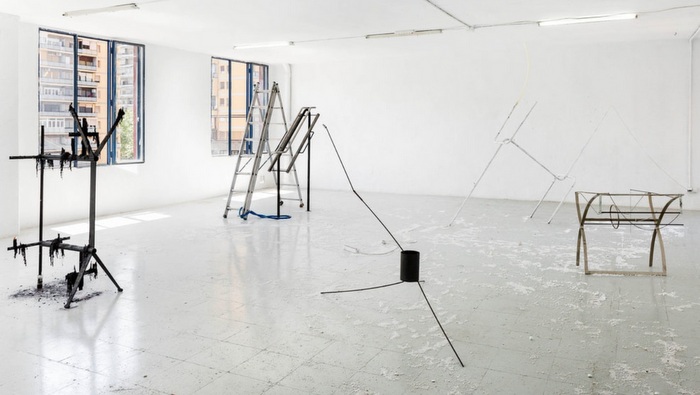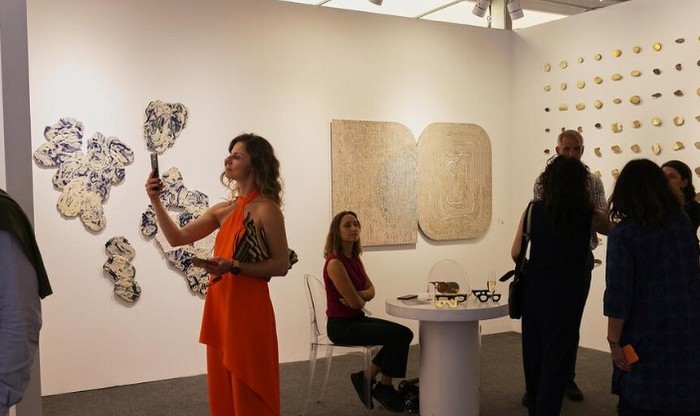SOLO by Fundació Vila Casas is a program curated by independent curators Carla Gimeno Jaria and Margot Cuevas, in collaboration with the Vila Casas Foundation. It presents four independent projects from the Catalan territory that generate dialogues around identity with a proposal for an individual exhibition. This program seeks to promote the new curatorship while establishing links between territories of the Mediterranean arc. In this way, Swab reaffirms its roots in the territory and claims its local essence.
For this 2023 edition, SOLO by Fundació Vila Casas invites HalfHouse (Barcelona), F O C (Barcelona), Cultural Rizoma (Celrà) and Espai19 (Barcelona). During the SWAB fair, these four self-managed spaces, which are configured as non-profit projects, present individual exhibition proposals that together generate a portrait of contemporary artistic trends in the local context. Based on different materializations, each project will allow us to glimpse the ways of working and the idiosyncrasies of each space, claiming different ways of doing and working with artistic practice.
SOLO SPACES
Halfhouse, Barcelona
Espai19, Barcelona
Cultural Rizoma, Celrà
F O C, Barcelona

MEET THE CURATOR: CARLA GIMENO
We speak with Carla Gimeno
Carla Gimeno Jaria (Barcelona, 1994) is a curator, researcher and cultural manager. Carla Gimeno Jaria (Barcelona, 1994) is a curator, researcher and cultural manager.

– As a curator, what do you think makes Swab special or different as a fair?
Swab is a fair that over the years has managed to maintain its essence with an intimate and close format. Despite the international projection of the fair, the program always focuses on a local and emerging perspective, which I consider differentiates it from other fairs. This format allows visitors to observe the proposals of each gallery or space in detail while bringing them closer to the artistic reality of the Catalan territory. And this is a kind and necessary gesture.
– What artistic or curatorial trends do you think will be established in the coming years?
I think we are in a very delicate and unstable moment, but very powerful. Socially, there is an inherent need to rethink how we live and how we relate, with people and with nature. And this, inevitably, is reflected in both artistic and curatorial practices. Personally, I increasingly see projects whose collaborative nature appeals to intersectional discourses. Collaboration, care, inclusivity, or environmental responsibility are processes that, in my opinion, will increasingly be present in artistic and curatorial projects, whatever their format.
– What are you interested in seeing or discovering at the fair in this new edition?
I really want to see the artistic proposals from the galleries in Barcelona. Every year new spaces are added and Swab is an ideal event to have a general image of what is happening in the city at a given time.
– What projects or artists are you working on now? What topics have you been concerned about in your research lately?
I am concerned about the violence that semi-capitalism applies to bodies and how this process has accelerated in recent years with the incorporation of new technologies, as tools for the commodification of emotions and affects. More generally, my research focuses on the search and speculation of forms of resilience in the oppressive structures that shape our imagination and reality.
-How would you define your curatorial practice?
It is difficult to think about my curatorial practice from a specific place, but I suppose I understand it as a sustained process of questioning and research around my concerns that is formalized and enriched by collaboration with artists, curators or friends. For me, collaboration is essential, not only when I work on a specific project with one or more artists, but on a day-to-day basis, because it often gives me different readings and points of view that make me rethink things. I also like to think of curatorial practice as an open and blurred space that is nourished by processes of relationship, encounter and dialogue with the practice of the artists with whom I work and that can generate debates, circumstances and unexpected dislocations.
MEET THE CURATOR: MARGOT CUEVAS
We speak with Margot Cuevas
Margot Cuevas Orteu (Barcelona, 1995) is an independent curator and directs the exhibition space Raccoon projects.

– As a curator, what do you think makes Swab special or different as a fair?
What makes Swab special or different as a contemporary art fair may vary depending on the edition and artistic trends of the moment, since in each edition you discover new galleries and proposals. I would highlight the focus and marked interest that the fair has in emerging artists and galleries, making them known and offering them a platform for both national and international visibility. I would also highlight artistic diversity, because Swab hosts a wide selection of styles, thus being a diverse and inclusive fair.
– What artistic or curatorial trends do you think will be established in the coming years?
Anticipating future art trends can be challenging, as art is a constantly evolving field and trends can change quickly. However, there are some trends and themes that have clearly been emerging in recent years and will continue to develop. For example, environmental awareness about climate change and sustainability, many artists are exploring themes related to nature, sustainability and the relationship between humans and the environment. Issues such as social justice, gender equality, human rights and other political and social issues are also on the agenda. Many artists are revisiting their history and identity, especially from a postcolonial perspective. This trend could continue to develop as forgotten or marginalized narratives are given voice.
It is important to note that art trends are subjective and can vary by region, art community, and world events. Therefore, it is interesting to follow the work of emerging artists and contemporary art exhibitions to stay up to date with current and future trends.
– What are you interested in seeing or discovering at the fair in this new edition?
Swab always has very interesting curated programs, this year for example I really want to see the Emerging Latam program curated by Santiago Gasquet, which brings the most innovative and young galleries from the Latin American scene. I am also very interested in the Video program curated by Alfonse Chiu, which will feature several works by artists from the Southeast Asian context, a context that I really want to know more about.
– How would you define your curatorial practice or what projects are you working on now?
Right now I’m focused on the project I started a year ago. Raccoon projects is a curatorial exhibition space where I invite artists to learn more about their practice and work together on a process and a body of work that is then presented to the space in an exhibition format, although it is not a final requirement. I am interested in how I can influence the body of work and the artistic practice and how links of continuity can be established in non-gallery formats.
On the cover: Halfhouse, Barcelona
Source: Swab Barcelona
Related Publications

EXPO CHICAGO Contemporary Art Fair: Galería Artizar
April 15, 2025













